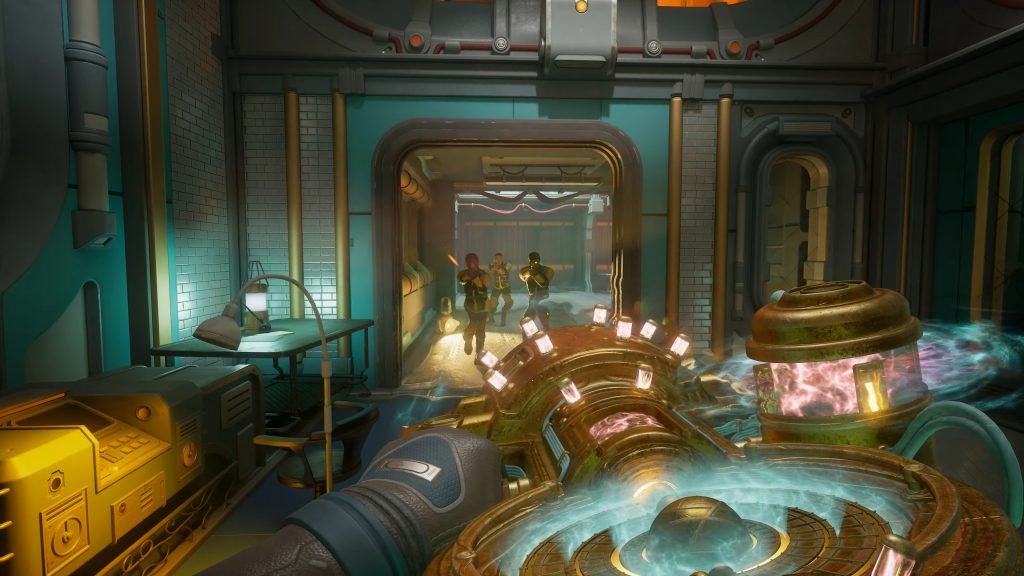Diplomacy, subterfuge, violence, persuasion – there are many paths to space-walk in The Outer Worlds 2. We can dissect the sequel’s changes, refinements, and enhancements – indeed, we have, in our “15 Biggest Differences” feature which compared The Outer Worlds 2 to its 2019 predecessor – but the breadth of viable playstyles inside this sci-fi sequel points to one thing: genuine artistic vision, and a determination on the developer’s part to fully realise the ideas that didn’t make it to Halcyon. Shoot for the stars, you might land on the moon, they say.
Now, six years later, The Outer Worlds 2 is set to blast beyond the moon into interstellar space. From its tangible choices and consequences, to tonal shifts and those aforesaid playstyles, here’s 15 things to know before buying The Outer Worlds 2.
Built for Modern Hardware
The Outer Worlds 2 is releasing exclusively on modern hardware – Xbox Series X|S, PC, PS5 – with sharp textures, rich lighting and particle effects, all presented in buttery-smooth 60fps, preceded by fast loading times. Sequels always aim for bigger and better, but this is a follow-up which feels more expressive – from the way NPCs move and talk, to its stylised propaganda artwork. The Outer Worlds 2 eschews cross-generational compromise for modern exclusivity, with ultra-immersiveness and convincing emotional depth awaiting.
A Tonal Shift
A pastiche on early 20th-century capitalism, The Outer Worlds’ wry humour pulled no punches critiquing corporate culture amid Art Nouveau opulence. While its edge remains sharp throughout, a darker tone permeates the sequel. As the machinations of three power-hungry organisations compete for dominance, players will pull similarly disparate threads. Their actions will reflect the overarching conflict’s perplexity – disconcerting one minute, hostile the next.
Choose Your Allegiances
Throughout their journey, players can oppose or align with Arcadia’s trio of incompatible factions – to engage with their ethos, or face the consequences. Neither entity is clean; each choice a dilemma occupying gray middle-ground. Still, every decision sends a charge rippling through the colony – shocking alliances and overloading corporate circuitry, with ramifications re-wiring the landscape in real-time.
Decisions More Central Than Ever
While specific narrative detail is light, The Outer Worlds 2’s unwaveringly deep RPG systems means its story will pivot – sometimes dramatically – following a player’s decisions. But it’s not just narrative that will respond to a player’s impulse – from shifting corporate agendas and geo-political manoeuvring, to the denizens’ morale which oscillates through Arcadia, everything thrums to a player’s syncopated rhythm like multiple orchestras following the same conductor. The result is a world with tangible energy – lively, responsive, and alive.
Emphasis on Replayability
Anchoring The Outer Worlds 2’s focus on player choice is a bold restriction: characters cannot be respecced after creation. Whilst potentially controversial, this design choice ensures each skill, trait, perk, and progression system has weight. Once choices are made, the inability to respec is the gravitational pull keeping everything in orbit. Players need to double-down, plan carefully, and – as not all attributes are universally positive – potentially live by their mistakes. On the flipside, the no respec rule emphasises replayability. By accepting this limitation The Outer Worlds 2 gives profound reactivity in return, ensuring different builds feel unique for each run.
Renewed Focus on Combat Variety

Combat wasn’t The Outer Worlds’ strong suit. To remedy this, The Outer Worlds 2 introduces more viable and strategic options. The sequel’s gunplay is more expansive, yes, but avoiding combat via stealth is now just as credible a tactic as a gung-ho approach. For proof, almost every one of Arcadia’s environments has been designed with a surreptitious path. Combat’s potential to shape the narrative reinforces the sequel’s choice-led design, where moment-to-moment strategy now matters as much as long-term progression.
Non-Lethal Runs Possible
Yes, The Outer Worlds 2 supports pacifism. Opting for the sneaky route won’t lead to punishment. In fact, given the wealth of attributes for character progression plus plethora of environmental and conversational skill checks throughout, extreme playstyles are equally viable: a psychopathic soldier who murders his allies, a politician skilled in persuasion, or a complete moron who can’t operate machinery, The Outer Worlds 2 is a playground for experimentation – its various RPG systems combine harmoniously to reward even the most offbeat ideas.
Environmental Hazards Charge the Landscape
Arcadia isn’t just host to warring ideologies, but players will need to negotiate and adapt to environmental hazards. Some are natural, like the interdimensional rifts that’ll vapourise our playable Earth Directorate Agent if they get too close, and hostile wildlife – mixing familiar creatures from the first game with new, mutated forms – requiring players to be prepared for any out-of-settlement excursion. Other hazards are man-made – malfunctioning automated systems, such as fire suppression alarms which inadvertently suck all oxygen out of a room, or toxic coolant which spews out the bullet holes of a downed mech.
More Cinematic Presentation
More time and bigger budgets means premium cinematics, with The Outer Worlds 2 chock-full of in-engine cutscenes. Rendered beautifully, with enhanced camera work injecting a dynamism missing in the first entry. Improved presentation doesn’t just make the game’s saturated style look better, but it heightens immersion – no longer are players greeted with a loading screen when entering a building, for instance. These seamless transitions reward exploration as nowhere across Arcadia’s alien biomes feels off-limits.
Quality of Life Upgrades
Our “15 Biggest Differences” feature dissected most of The Outer Worlds 2’s quality of life improvements, but the sequel has even more upgrades worthy of discussion. For instance, item consumption in the first game halted exploration with flow-interrupting menus. The Outer Worlds 2 discards that pause, letting players consume items without picking them up via the all-new direct consumption feature. Enemy health bars are upgraded with one-shot indicators, appearing when a weapon can kill with a direct hit, hinting at tactical switch-ups to maintain mid-fight momentum.
It’s a Standalone Adventure

The Outer Worlds 2 takes place in a distant space colony new to the series, with only one faction bearing influence from its predecessor. This choice isn’t just to respect the narrative decisions made by players of the first game but to give newcomers the ideal start point. This sequel is a completely standalone adventure, and the odd secrets aside, players do not require prior knowledge of the series to get the most out of it.
Release Date, Platforms, and Pre-Order Bonuses
The Outer Worlds 2 launches on 29th October on Xbox Series X|S, PC via Steam, and PlayStation 5. It’ll be available day one on Game Pass, with no word on whether it’ll ever come to PS Plus. Players who pre-order will receive Commander Zane’s Anti-Monopolistic Battle Pack at launch, including Zane’s Pistol and Dagger, Zane’s Uniform Armour, and the Pet Ed Drone.
The Price: Once Divisive, Now Reduced
While other platforms have begun, or are phasing in, the more premium price point, there was disarray amongst players when The Outer Worlds 2 announced it’d retail at $80. Whether in response to large-scale bafflement or lower-than-expected pre-orders, that once divisive price has been reduced to $70 – a move Microsoft claims is “in line with market conditions”. Whilst the sequel’s since gone gold, it feels like when, not if, for $80 games.
Not Concerned With Price? There’s a Premium Edition
The Outer Worlds 2’s Premium Edition retails at $99.99, which isn’t a massive hike over the base price for what’s included. Spending the extra $30 nets Commander Zane’s aforesaid Battle Pack, plus Moon Man’s Corporate Appreciation Premium Prize Pack, digital artbook and soundtrack, 5 days early access, and a DLC pass for two future story expansions.
PC Requirements
Minimum system requirements include an AMD Ryzen 5 2600 or Intel i5-8400 processor, and an AMD RX 5700, Nvidia GTX 1070, or Intel Arc A580 GPU. Recommended spec includes an AMD Ryzen 5 5600X or Intel Core i7-10700K processor, and an AMD Radeon RX 6800 XT or Nvidia RTX 3080 GPU. Whatever the hardware, a 16GB RAM is needed alongside 110GB storage space.


